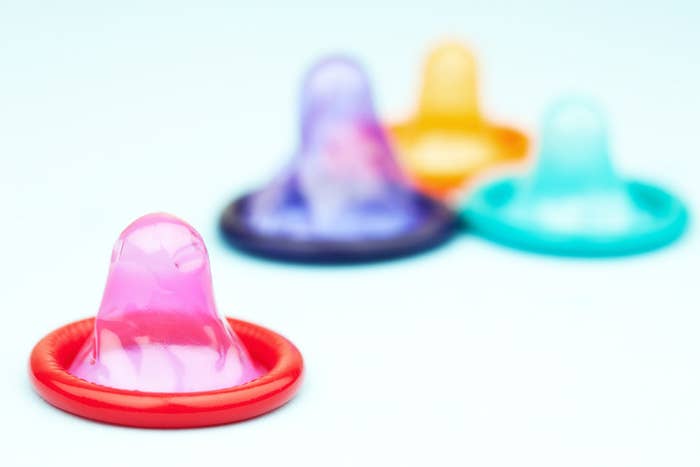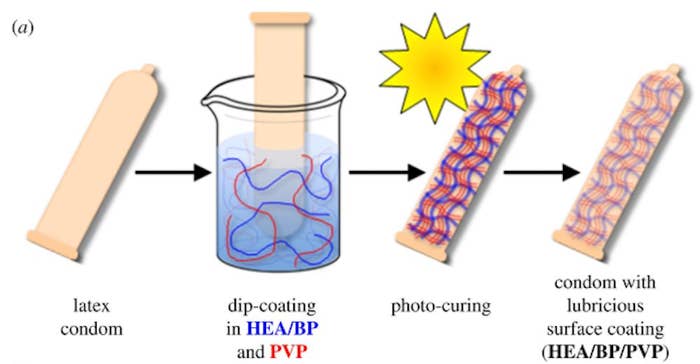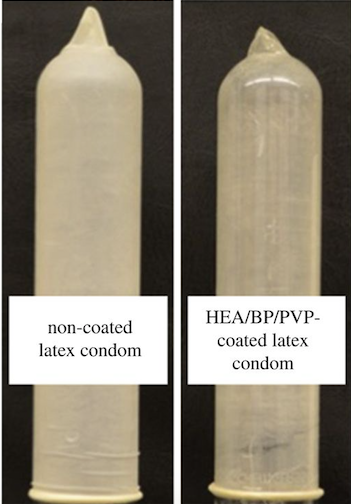
Condoms are great for preventing sexually transmitted diseases and pregnancy, but people don’t always use them when they should. In fact, about 34% men said they used condoms but not every time, and 24% of women with male partners said they used them. And at the same time, rates of sexually transmitted diseases are hitting record levels, and just under half of all pregnancies are unplanned.
In an effort to make condoms a bit more, um, palatable, scientists have developed a condom that may solve at least one key problem — inadequate lubrication. These experimental rubbers are coated with special hydrophilic (meaning “water-loving”) polymers that give them a lubricantlike feel, but one that’s more durable than your average lube.
“The coating that we’ve made actually holds on to the water at the surface, and that’s what gives it its slippery feeling,” Mark Grinstaff, a professor of biomedical engineering, chemistry, and medicine at Boston University, told BuzzFeed News. “As soon as you put it in the presence of water or bodily fluid, it will become very, very slippery.”

How durable are they? Each one is good for 1,000 thrusts, according to a study by Grinstaff and colleagues in Royal Society Open Science. That should be more than enough, the researchers said, because the average sex act is only 100 to 500 thrusts, which TBH, still sounds like A LOT.
“We were trying to test if the condom would retain its lubriciousness in extreme situations — that is why the count is that high,” Grinstaff said.
That relatively high thrust count, however, has made some people speculate that maybe this means the condom is reusable. So we want to just take a minute to remind everyone that you should never, ever wash and reuse condoms, and in fact, the Centers for Disease Control and Prevention tweeted about that earlier this year.
“These are not reusable,” Grinstaff confirmed.
These condoms are experimental, meaning they’ve never been used for sex before. And since BuzzFeed News is skeptical, and thought maybe a grad student would have been tempted to try one at home, we asked Grinstaff if it’s really true. He laughed and said, “no, we’re trying to be very good about that.”
So in the new study, 13 men and 20 women, 24 to 58 years old, evaluated the condom’s potential by rubbing (with their fingers) three different types of latex: the polymer-coated latex, personal-lubricant-coated latex, and noncoated latex. The latex was evaluated before and after being submerged in water.
“We were surprised and delighted to learn that in fact many people said they would use this condom, and more importantly, those people who said they didn’t use a condom regularly, many of them indicated that they would use the condom if it had this type of property,” said Grinstaff. “So that was really encouraging.”

Condoms usually are sold with a coating of silicone oil lubricant, which can come off during intercourse and may no longer be lubricating, Grinstaff said. “That’s the same problem with the personal lubricants — those are water-based, and when you apply those, it gets washed off during intercourse and your lubricity decreases.”
Oil-based lubricants, like baby oil or coconut oil, aren’t safe to use with condoms because they break down latex. (Check out our handy guide to finding the right kind of lube for every kind of sex.)
The Bill & Melinda Gates Foundation, which partly funded the new study, put out a call to researchers in 2015 to look for ways to improve the condom to help lower the risk of sexually transmitted diseases, Grinstaff said.
“It took about three years and four or five students working on and off to come up with an idea that was reasonable,” Grinstaff said.
Grinstaff has a financial conflict of interest because he stands to profit if these condoms turn out to be popular. (He is a shareholder in a company that’s being launched by one of the study’s authors.)
And the condoms still need to be developed as a product, tested in clinical trials, and approved by the FDA before they can be sold. Grinstaff estimates they might be available in a year or two and that they shouldn’t cost more than regular condoms.
“We certainly know there’s been an increase in sexually transmitted diseases and we’d like to think if the condom performed better, or better in terms of the expectations, then users would use it more,” he said. “If users use it more, then maybe we can reduce the rates, and that would be excellent.”
